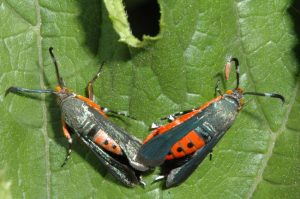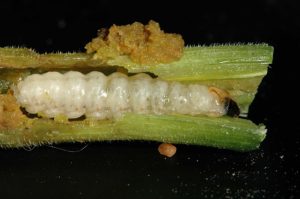Sweet Corn IPM Newsletter No. 3 – July 7, 2017
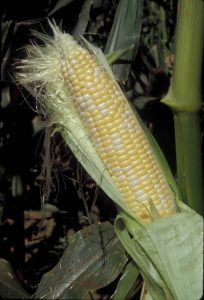 Sweet Corn IPM Newsletter No. 3 – July 7, 2017
Sweet Corn IPM Newsletter No. 3 – July 7, 2017
Click on photos to enlarge.
Highmoor Farm Field Day
Wednesday, July 26, 2017
Save the date!
CORN EARWORM ACTIVE IN SILKING CORN FIELDS
European Corn Borer Feeding Increasing in Pre-Tassel Fields
SITUATION
Early corn, planted under plastic mulch or row covers is coming into silk this week, while early corn planted without plastic is now in pre-tassel. Warmer growing conditions have kept corn growth at a brisk pace, but has allowed increased insect activity in some fields. Sprays have been recommended for both European corn borer and corn earworm this week.
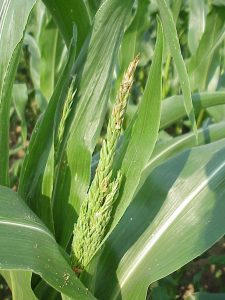
European corn borer: Moth captures were lower in most locations this week, but larval feeding activity was found in nearly all the fields we scouted. Most fields were still under the recommended spray thresholds of 30% of whorl-stage plants showing feeding injury or 15% of pre-tassel plants. Fields in Bowdoinham, Cape Elizabeth and Wells were over threshold for either whorl or pre-tassel corn, so sprays were recommended. In silking corn, the sprays may be based on the number of corn borer moths caught in pheromone traps to prevent moths from laying eggs on the flag leaves of the ears, which could lead to larvae infesting the ears. One early silking field in Cape Elizabeth was over the 5-moth threshold, but the field was also on a spray interval for corn earworm, so no additional sprays should be needed.
Corn earworm: We continue to catch moths at some, but not all locations, and in relatively low numbers. The weather has been conducive to more moths flying northward, and egg laying at night, so growers with early corn should be on the alert to protect any silking fields if moths are found in the area. A 6-day spray interval for corn earworm was recommended for early silking fields in Wells and Dayton this week. A 5-day spray interval was recommended for silking fields in Cape Elizabeth and Lewiston. When no silking corn is available, corn earworm larvae may chew large, ragged holes in the leaves, similar to fall armyworm. This should be counted in field scouting for European corn borer and fall armyworm.
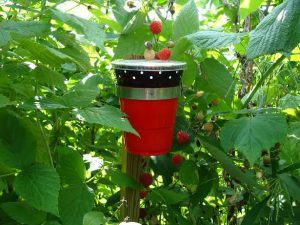
Fall armyworm: No moths have been captured in our pheromone traps this week, and no feeding damage has been reported. We do expect that moths will be arriving soon, as they typically follow corn earworm into Maine by a few days to a few weeks.
Spotted wing drosophila: Flies have been caught in other New England states this week, and Dr. Frank Drummond, University of Maine Entomologist, reports flies found in Stockton Springs. We have found one female SWD from a trap in Buxton. Growers with ripening blueberries or raspberries should be on the alert for flies or larvae in the fruit.
Squash vine borer moths were caught in pheromone traps in Wells, Biddeford, Oxford and New Gloucester this week. Only the Wells site was above the 5 moths per week spray threshold, and a spray was recommended, but the captures in other locations indicate that this pest is now threatening summer squash, winter squash and pumpkins in Maine fields. Growers with squash in southern Maine should be on the lookout for vine borer symptoms and protect squash plants if moths or damage are seen. See the 2016-2017 New England Vegetable Management Guide for control options.
- Two Squash Vine Borer Moths; photo by Jeffrey Hahn, Univ. of Minnesota Extension
- Squash Vine Borer Larva; photo by Jeffrey Hahn, Univ. of Minnesota Extension
Sincerely,
David T. Handley
Vegetable and Small Fruit Specialist
Highmoor Farm, P.O. Box 179, 52 US Route 202, Monmouth, ME 04259, 207.933.2100
UMaine Extension Diagnostic Research Lab, Pest Management Unit, 17 Godfrey Drive, Orono, ME 04473, 1.800.287.0279
| Location | CEW Moths |
ECB Moths |
FAW Moths |
%Feeding Damage |
Recommendations / Comments |
|---|---|---|---|---|---|
| Biddeford | 1 | 0 | 0 | 20% | No spray recommended (corn not yet pre-tassel) |
| Bowdoinham | 0 | 1 | 0 | 22% | One spray recommended for ECB |
| Cape Elizabeth I | 0 | 0 | 0 | 1% | No spray recommended |
| Cape Elizabeth II | 5 | 6 | 0 | 20% | 5-day spray interval recommended on all silking corn |
| Dayton I | 1 | 0 | 0 | 2% | No spray recommended |
| Dayton II | 3 | 0 | 0 | 9% | 6-day spray interval recommended on all silking corn |
| Farmington | 0 | 0 | 0 | 7% | No spray recommended |
| Lewiston | 4 | 0 | 0 | 2% | 5-day spray interval recommended on all silking corn |
| Nobleboro | 1 | 0 | 0 | 7% | No spray recommended |
| Oxford | 0 | 1 | 0 | 1% | |
| Poland Spring | 0 | 0 | 0 | 21% | No spray recommended (corn not yet pre-tassel) |
| Sabattus | 0 | 0 | 0 | 26% | One spray recommended for ECB |
| Wayne | 0 | 0 | 0 | 19% | One spray recommended for ECB on pre-tassel corn |
| Wells I | 0 | 0 | 0 | 19% | One spray recommended for ECB on pre-tassel corn |
| Wells II | 3 | 0 | 0 | 6-day spray interval recommended on all silking corn |
CEW: Corn earworm (Only fresh silking corn should be sprayed for this insect.)
ECB: European corn borer
FAW: Fall armyworm
| Moths caught per week | Moths caught per night | Spray interval |
|---|---|---|
| 0.0 to 1.4 | 0.0 to 0.2 | No spray |
| 1.5 to 3.5 | 0.3 to 0.5 | Spray every 6 days |
| 3.6 to 7.0 | 0.6 to 1.0 | Spray every 5 days |
| 7.1 to 91 | 1.1 to 13.0 | Spray every 4 days |
| More than 91 | More than 13 | Spray every 3 days |
Thresholds apply only to corn with exposed fresh silk. Lengthen spray intervals by one day if maximum daily temperature is less than 80°F.
European Corn Borer Thresholds
Whorl stage: 30% or more of plants scouted show injury.
Pre-tassel-silk: 15% or more of plants scouted show injury.
Silk: 5 or more moths caught in pheromone traps in one week.
IPM Web Pages:
UMaine Cooperative Extension Integrated Pest Management
Penn State Pest Watch for Sweet Corn
UMass Amherst Integrated Pest Management
Where brand names or company names are used, it is for the reader’s information. No endorsement is implied nor is any discrimination intended against other products with similar ingredients. Always consult product labels for rates, application instructions and safety precautions. Users of these products assume all associated risks.
The University of Maine is an equal opportunity/affirmative action institution.

